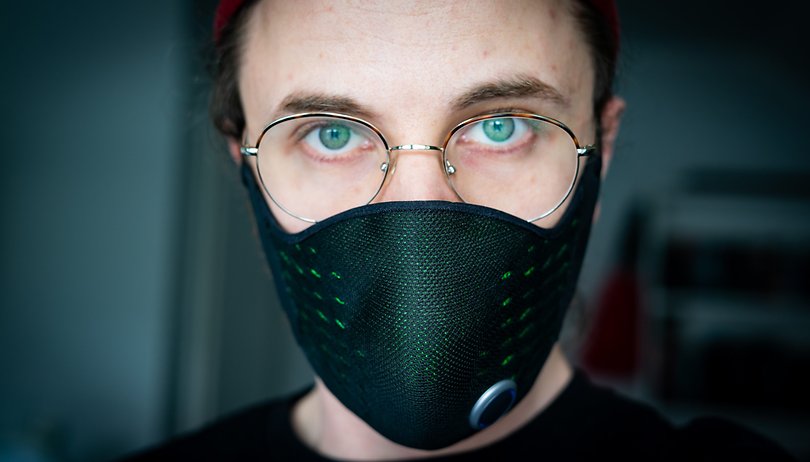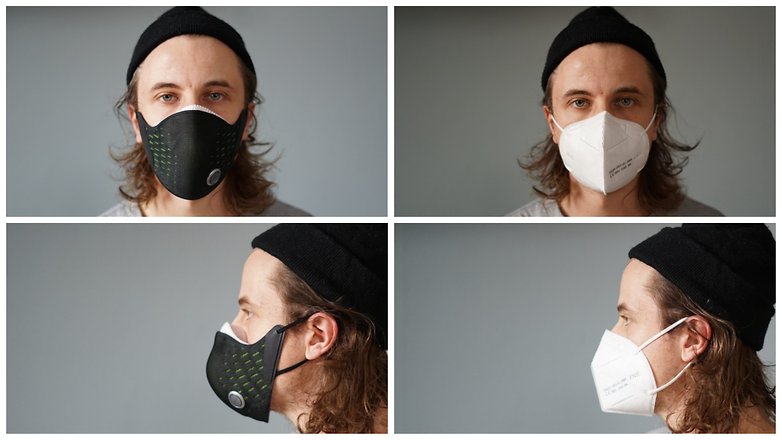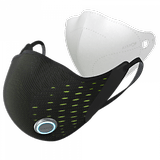AirPop Active+ Halo review: Are smart masks the next big thing?


The Active+ Halo by AirPop is a smart face mask that can record your breathing data! If you do not understand how it works, don't worry. This is because I have tried this face mask and will tell you whether you should spend almost €150 on it.
Good
- Very good filtration
- Far more stylish than white medical masks
- Sustainable as filters can be used for 40 hours each
- High-quality workmanship
- Filter change reminder
Bad
- Humidity problems in cold temperatures
- Currently available for Apple users only
- Rather high entry cost
- Breathing rate is not optimal

A brief summary: Sustainable with its flaws
With the AirPop Active+ Halo, you have at your disposal a high-quality -and more importantly - safe face mask that protects you against viruses, fine dust, and many other potentially dangerous particles. This is made possible courtesy of a combination of a filter and an outer shell, with the protective shell providing a stylish layer of protection. It is so much better looking compared to boring, conventional masks.
Do note, however, that my attempt at keeping track of my respiratory data while indulging in sports activities did not work too well during the course of this review. The main issue I faced was the build-up of moisture in the mask, which further weighed down my breathing (by a considerable amount after three kilometres). This eventually affected the tracking. Furthermore, the data obtained after this process is also rather difficult to classify. Apps from other wearable brands often give you far more useful and accurate data.
Additionally, the high entry price of the AirPop Active+ Halo at $149.99 and the subsequent filter costs will probably be a deterrent to potential customers. This is because the air quality in Germany (where I tested this) is significantly better than over in China - the market for which the Active+ Halo was originally developed for.
Smart features: Why the Active+ Halo requires a battery
Shortly after CES 2021, I spoke to AirPop founder Chris Hosmer about the Active+ Halo and smart face masks in general. Indeed, there were quite a few smart masks showcased at the consumer electronics show in Las Vegas, including as the MaskFone, which included a phone function to a breathing mask.

However, AirPop has no such intentions and focuses on something more related to the basic function of a breathing mask. Dubbing it Halo, the sensor you notice as a small "plug" inside the mask measures your respiration rate and relies on your location data to calculate the number and type of particles that were filtered while you were wearing it. At the same time, AirPop can also tell you exactly when you need to change the replaceable filters.
The health data, or "breath data", can then be viewed in the Halo app on your smartphone. At the time of publishing, the app was only available on iOS. Here, you have the added advantage that the data also ends up duplicated in the Apple Health app.
The Halo app itself can either be synced manually after wearing it, or you can rely on one of the three tracking modes. According to the app, it is compatible with cycling, walking, and running. Adding to the convenience is the ability to record the distance ran after enabling location sharing.
Tracking and humidity problems
It all sounds good in theory so far! In reality, however, I ran into quite a few problems with the AirPop Active+ Halo. Although the mask connected to my iPhone and the display even showed me data about the humidity levels in the sensor and the temperature, it does not record my breathing.

In order to troubleshoot, I disconnected the mask halfway through, removed the battery to reboot it, and downloaded the latest beta version of the app via TestFlight on AirPop's advice. Hence, I doubt that I am able to obtain reliable tracking data over the course of time.
Mind you, the only reason I bothered with the Smart Mask as much as I did was because I really wanted to review it thoroughly. If I had paid the MSRP of about €150 and faced so many problems afterwards, I might have requested for a product return instead. It is far more than just annoying, especially if you stand in your jogging shoes for 20 minutes in front of your house door just because it simply fails to begin tracking your movement, instead of pounding the pavement and racking up those miles.
Comfort and sportiness: Useless after running a few km
The Halo app that Chris Hosmer recommended at the beginning of the review was for me to wear the AirPop Active+ Halo when I go jogging. This is because the face mask not only allegedly protects you against viruses and bacteria, but also against nasty air particles (more on that below). So if you're like me and often jog along four-lane highways, a mask against air particles could be a healthier option.
To prevent you from breathing in unfiltered air, AirPop surrounds the replaceable filters with a ring of polypropylene that you have to bend a bit in order to wear. It takes a while to get used to doing so, but with a little bit of practice, wearing the breathing mask is no problem at all, and when you can feel the slight movement of the filter as you inhale and exhale means you have worn it correctly: No more bad air coming through!

But the tracking issues weren't the only thing that upset me throughout the review duration. I would like to move on to another major weakness of the Active+ Halo: comfort levels while exercising.
The combination of the inserted filter and the soft touch membrane with breathable pores is responsible for both the inhalation and exhalation process. Hence, the slight lift-off that you might be familiar with from N95 masks doesn't exist here. Instead, the air is supposed to escape in such a manner that a tiny air cushion is created in the cavity between the lips and the mask. This aerodrome design, for which the company invented a manufacturing process dubbed "Airknit," allows AirPop to prevent wearers from re-inhaling exhaled CO2.
Let us give that statement the benefit of the doubt, even if it's hard to verify. Intuitively, I would have thought that upon exhalation, air with carbon dioxide would be collected here as opposed to escaping. I confirmed this suspicion when I breathed in very lightly with the AirPop. When I wore it for the first time, I felt like I wasn't breathing in enough air.
Apart from that, there is the slight rubber smell that the mask emanates shortly after unpacking. However, this feeling of not getting enough air is more likely due to the fact that the AirPop actually hardly lets any air through at the sides. After all, the goal in mind to offer protection against viruses or fine dust, and this is a good thing. Compared to cloth masks and N95 masks, this was the first time I felt like I was properly protected.

When indulging in sports, I still felt a little bit unusual at first, as it proved to be particularly difficult to breathe. The amount of blood required to oxygenate my working muscles when exercising surely increases as opposed to when I am resting, and when trying to exercise with a blocked nose, that is an instantly noticeable performance degradation.
On my regular jogging route, I had to remove the mask after a maximum of three kilometres. Breathing became too difficult to continue running without feeling dizzy.
The problem lies in the fact that moisture begins to build up in the mask, which meant that hardly any air reached me. I experienced this problem more often during the review duration. However, upon enquiring of AirPop, they assured me that these were not issues that they had known or encountered, but attributed it to the low surrounding temperatures instead. As a solution, I should try to exhale through the nose - which is the exact opposite of what running techniques taught me.
Filtration and air quality in Germany
I've already talked a little about the filter, but let me touch on the filtration briefly. AirPop states the efficiency of the replaceable filters is 99% for PM2.5. This translates to fine dust that has an aerodynamic diameter of less than 2.5μm. According to the manufacturer, it encompasses includes allergens, aerosols, and microbes.
Apart from the obvious use of it as protection against viruses while shopping, the filters also protect against fine dust in any large city or against pollen if you're allergic to those.
With the AirPop Active+, you receive actual protection, because even "dangerous fine dust" that is between 2.5 and 10 micrometers is filtered. Hence, the protective function of the AirPop mask is very good! However, the fine dust pollution in Germany cannot be compared to China.
Air quality: Do I need a breathing mask in Berlin?
China's capital Beijing has an air quality index of 201, which is considered very unhealthy, according to Aqicn.org. The pollution level for PM2.5 particulate matter on March 26 peaked at 251, which is far above the limit of 50 μg/m² set for Germany.
In Berlin, Germany's largest capital, this critical value of 50 μg/m² is rarely exceeded. This data can be obtained from the homepage of the Berlin Air Quality Measurement Network. These are, of course, values that describe entire city districts. If you ride your bike on the street in big city traffic, you might be exposed to a higher level of pollution than if you were to cycle behind a truck.

According to the Federal Environment Agency, however, the trend in particulate matter emissions has been steadily declining since 1995. This is due, among other things, to changes in energy production and more effective filters in vehicles. I don't want to make a definitive statement about whether you have to wear a mask in Germany, but the fine dust pollution in this country is still significantly lower than the levels found in China.
Pricing & maintenance: It costs €150 in Germany
I briefly mentioned that AirPop is launching its first Smart Mask in Europe for €149.99. In addition to the washable outer shell and the removable Halo sensor, the starter kit contains four interchangeable filters. Each individual filter is rated for 40 hours of use (active usage, the time doesn't expire after unboxing). This means after 160 hours, you'll need to buy another filter pack.
Four more AirPop certified filters cost €24.99 and you are unable to use a cheaper alternative or third-party filters. The fact that you have to scan each new filter with a QR code in the app is a protection for both you and the manufacturer, as this provides users with peace of mind that they will actually benefit fully from the quality and authenticity of the filters.
This is worth mentioning but not really relevant: the Halo sensor is powered by a CR1632 coin battery. These are not very common in Germany, but can be ordered on the Internet for a few Euros. According to the manufacturer, it is highly recommended that you change the battery every six months. During the review, however, I had to change the battery once - but I suspect that it is more of a faulty battery issue that was included with the review unit than anything else.
Conclusion: I've been looking for break free...
... but I found it difficult to breathe! Was I being strangled?
At first, I was very excited about the AirPop Active+ Halo - until I reviewed it. This may sound a bit harsh, as the Smart Mask is basically a very good idea and has been implemented in a high-quality and clever manner. However, using it was accompanied by its fair share of problems.
The tracking function did not work properly as intended in the review and the data obtained would not have helped me too much even as an enthusiastic runner, let alone a professional one. Rather, I felt that wearing the mask limited my performance while running, as moisture built up in the filter and I started having trouble breathing. I myself will not continue to wear the AirPop Active+ Halo after reviewing it - the problems and limitations are too much for me.
To AirPop's credit, though, I have to give the mask's workmanship two thumbs up due to the high build quality and snazzy-looking app. Even with a rather high price tag of €149.99, you actually end up with a premium product. On the positive side as well would be the overall design and capable filtration performance.
Even if everyone is already an old hand at wearing on a mask properly, you run the risk of medical masks slipping, especially when worn for long periods of time. Since the actual filter is sealed with a final fold in the AirPop, with the outer shell holding the filter in place properly, I had the feeling of actually being safer when wearing the Active+ Halo.




















